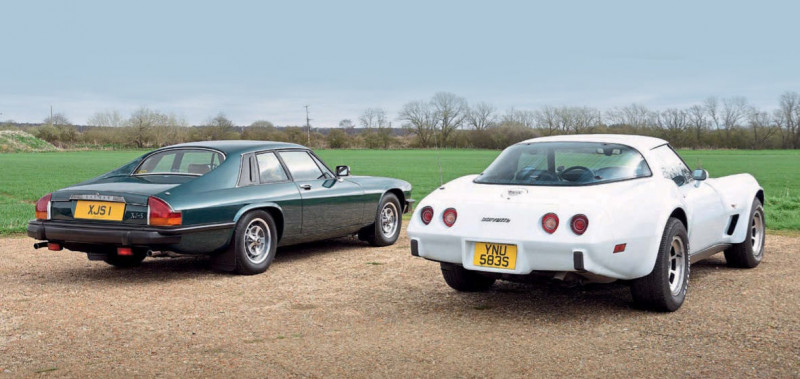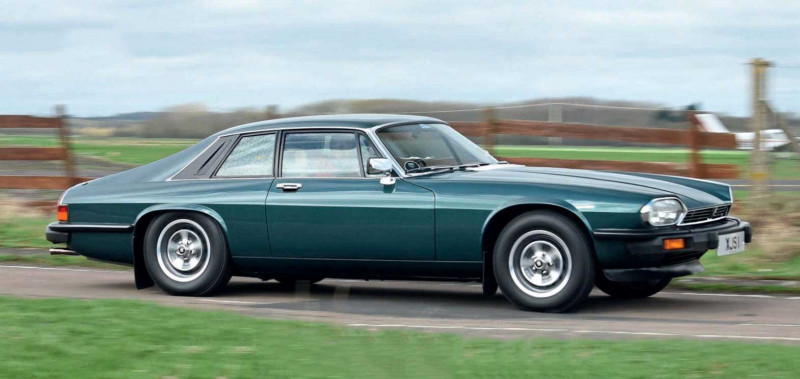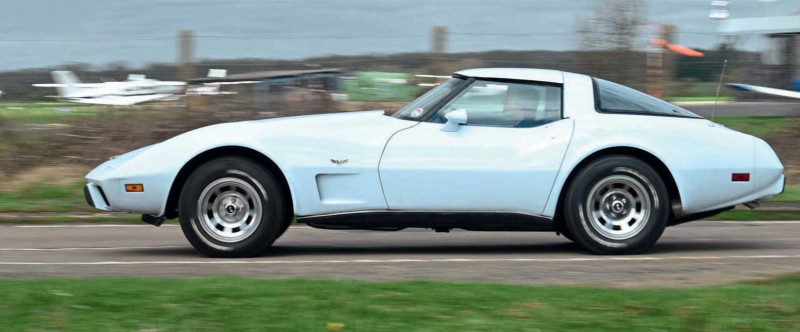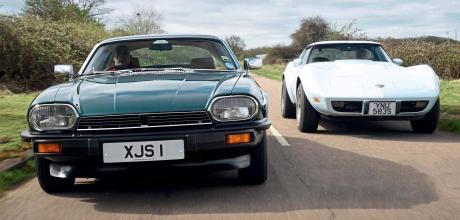1980 Jaguar XJ-S 5.4 V12 Auto vs. 1978 Corvette Auto C3
Both iconic performance cars, powered by even more iconic engines. We compare an XJ-S 5.3 with a Corvette 5.7. Words Richard Bremner. Photography Paul Walton.
British refinement or American muscle
Jaguar XJ-S vs Chevrolet Corvette As high-performance sports cars of the Seventies, the XJ-S 5.3 and Chevrolet Corvette 5.7 were rivals, but one centred around refinement, the other brute force. We compare one of each to decide for ourselves which is now best

All have had the performance of real sports cars, some dramatically so, the base engine’s power soon rising to 200bhp
Here are no less than 20 pistons under the bonnets of this pair. A dozen pump within the cylinders of an engine famous for its sophisticated technological extravagance, the remaining eight in an engine staggering in the scale of its popularity and the generous power bestowed by its rhythmic V8 beat
Half a century ago, Jaguar released one of the most magnificent engines of the 20th century. The 5.3-litre V12 was a masterpiece of velvety, internally combusted power and, despite its complexity, a robust and reliable power plant. Jaguar has made many superb internal combustion engines, and still does, the supercharged V8 among them. But the V12 is one of the high spots in its history of internal combustion engine development, not least for the boldness of introducing such an indulgent engine in the first place.

The V8 that powers this Corvette is Chevrolet’s small block – small in American terms – displacing 5.7 litres. That makes it bigger than the 5.3-litre Jaguar engine, but decidedly smaller than the 7.1-litre big-block V8 available in early versions of this third-generation Corvette. While a V8 seems over-cylindered to thriftier European eyes, for the Americans the small-block Chevy engine was the equivalent of our Ford Pinto and British Leyland A Series power units: a staple engine for the mass market.
Both the Jaguar XJ-S and Chevrolet Corvette were marketed using the models’ long heritage
The V12 Jaguar engine is anything but mass market, although it certainly did much to popularise a power unit favoured by supercar makers Ferrari and Lamborghini. Those four extra cylinders are not the only reason why the XJ-S and Corvette did not compete in period, of course, the Chevy pitched much lower as an affordable sports car from a brand selling cars by the million. The XJ-S came from a more rarified source, was more luxurious and more sophisticated, and priced accordingly. So, there are inevitably big differences in the standard of finish between these cars and, as we’ll see, in their construction and manners too.
Yet, there are many similarities. Both are effectively two-seaters, the rear accommodation of the 2+2 XJ-S being of limited use. Both are long-bonneted cars propelled by big engines, and both are aimed at enthusiast buyers with the express intent of entertaining them. They even share similar General Motors’ automatic transmissions. These days, as it happens, you can buy either for similar sums of money, too. And it’s the heart of both these cars – their engines – that do so much to define them.

Indeed, the small-block V8 probably saved the Corvette from an early death. The original 1953 C1 version launched with the so-called Stovebolt in-line six cylinder, a pre-World War Two engine that was too limp for the task of beating off a speedy Jaguar XK 120. While Ford had been making V8s for years, Chevrolet only caught up in autumn 1954, with an all-new for 1955 V8 – a V8 that was advanced in much of its detail design.
Library quiet is not necessarily the sensation you expect to dominate from a car so low and so long-of-bonnet
It was very compact, 50lb lighter than the Stovebolt and internally lubricated, many engines of the era featuring leak-prone external oil lines. Low-mass pressed-steel rocker arms allowed much higher peak revs, the pushrod tubes were hollow to transport oil, and the single-piece intake manifold also included the water outlet, the exhaust heat riser, the distributor carrier and the cover, bolted into the vee between the cylinders.
Much of this practice is commonplace now, but it was near revolutionary at the time. The advances didn’t stop there. The cylinder heads were crossflow and their combustion chambers wedge-shaped for efficiency, while the five cylinder head bolts surrounding each cylinder reduced the risk of head gasket failure and, to the delight of tuners, allowed for painless power boosts.
These were the foundations of an engine that started life in 1955 as a 4.35-litre, 265 cubic inches (cu in) motor, a relatively modest size by US standards. As installed in the 1955 Corvette it boosted output by 26 percent to 195bhp gross (grossly exaggerated by today’s standards, running without such ancillaries as an exhaust manifold and a dynamo) but was sufficient to give the ‘Vette the go to match its looks.
Capacity grew to 283cu in during 1957, 327cu in during 1962 and in 1967 the all-new Chevrolet Camaro appeared with the 350cu in (5,736cc) version, regarded as the high-performance version. If that wasn’t enough for the committed rubber burner, Chevrolet had launched a new, complementary 454cu in (7.4-litre) V8 in 1965. This big-block engine’s arrival led to Chevy’s standard V8 becoming known as the small block. The 350cu in would survive until the small block’s demise in 2003, 49 years after it first appeared.
By this time, it had been used by every General Motors nameplate apart from Geo and Saturn, despite major brands such as Buick and Pontiac having their own V8s. Around 100million small blocks of all sizes were made in that time, and – in truth – it’s not entirely dead now, GM supplying brand-new crate engines (so-called because that’s what they arrive in, rather than an entire car) for restorers and hot-rodders.
America was expected to be the main market for Jaguar’s new V12. “Such a unit would have extra appeal over the dominant V8 engines,” Jaguar’s power unit chief, Harry Mundy, explained at the Motor Show lecture he gave on 27 October 1971 at the Mayfair Hotel, London. The dinner-jacketed men of this smoke-hazed room would have their ears filled with details of experimental single-cylinder engines, the merits of single versus twin cams and Jaguar’s preference for timing chains rather than the growing vogue for cogged belts.
Mundy’s lecture was a highly detailed complement to the Earl’s Court unveiling of the E-type Series 3, Jaguar’s substantial reworking, turning the ten-year-old sports car into an effortlessly powerful grand tourer. Any disappointment there might have been at the E-type’s fattening was more than compensated for by the excitement of a V12, and for a fraction of the money that Ferrari or Lamborghini would charge for the privilege.
Mundy was undoubtedly aware of the need to explain this spectacular doubling of pistons. “The adoption of this particular cylinder formation with a large number of cylinders needs to be justified,” he said, reporting that the existing XK engine was reaching its developmental limit, partly because it was conceived under the old RAC taxation rules, which favoured long-stroke, narrow-bore cylinder architecture. That was good for torque, but less good for power, the resulting high piston speeds limiting the engine’s scope to rev. The third order of torsional vibration characteristics inherent to a straight-six also limited its potential.
The new engine’s main aim was to achieve more power more easily, the first of four key design requirements being that the V12 should produce as much as an XK engine in race specification, with a gross output of 330bhp. Other requirements were for a minimal increase in weight despite the doubled cylinder count, to contain costs, and that the engine must occupy the same space as the existing six-cylinder without the need for structural alterations to the current model range.
The last of these “was really the most difficult,” said Mundy, “and largely influenced the decision to use a single-camshaft per bank.” This, despite extensive work on a previous twin-cam per bank version developed with racing and road car use in mind. But there were plenty of advantages in the single-cam design, including weight, noise and cost reductions. Less obviously, the size of the twin-cam engine’s heads limited the angle through which the front wheels could be swivelled, risking a turning circle as unhelpful as the Suez Canal-jamming Ever Given. And, from the perspective of half-a-century later, the relative simplicity of the V12’s cylinder heads is one reason why this engine is so durable. Like Chevy’s small block the V12 evolved, if less extensively, Jaguar’s engine being produced in tiny numbers compared to the GM-motor. Fuel injection replaced carbuettors, the cylinder head was redesigned for High(er) Efficiency with the Fireball head, and eventually there would be a 6.0-litre version that replaced the 5.3, in 1993.
The version fitted to this 1980 pre-HE XJ-S had advanced on from the E-type version in having fuel injection rather than a quartet of carburettors. In either form, this is a legendarily smooth engine, a sensation only heightened by the GM400 automatic transmission coming with most V12s. You don’t feel anything as rude as vibration in this car, which, if anything, seems to get quieter as you add speed. That there’s so little wind noise and road roar only adds to the impression of huge refinement, even by today’s standards. The only spoiler is the air conditioning fan, whose roaring efforts are magnified by the silence elsewhere.
Library quiet is not necessarily the sensation you expect to dominate from a car so low and so long-of-bonnet, making it easy to see how those familiar with E-types – including the V12 – might have been slightly disappointed at its apparent lack of dynamic verve. But, that was deliberate, Jaguar boss Sir William Lyons believing that mile-mashing grand tourers would be the market’s desire, and given the slow-burning – but solid – success of the XJ-S, he was right.
It’s not only the Jaguar’s refinement that veils its abilities, the transmission does the same. Like every automatic, especially the older variety with no sport mode, its main on-the-move mission is to shift into top as soon as possible. With so much torque to process it’s not long before third gear is indeed achieved, the engine often revving to no more than 2,000rpm-2,500rpm as it shifts out of second. Drive like this, and it’s quite easy to think that an XJ-S V12 is never any more than brisk.
But, if you tug the thin-stemmed gearlever into second, the V12 gets its chance to sing. This is such a rangey gear in an XJ-S; you’ll soon make the exciting discovery that peak pull is a long way north of 2,000rpm, the Jaguar’s nose lifting slightly as the V12 fills its considerable lungs to ground-blurring effect.
If the road’s twisty, you must concentrate quite hard because, driven in this way, the XJ-S is as rapid as a speedy modern car, but without quite the same grip, roll-resistance, stopping power or electronic anti-skid protections. Which isn’t to say that its chassis is inadequate. The opposite is true in the context of the era, this car being well balanced, far from skittish and able to stop with reassurance that does not leave you in doubt.
It does all this while absorbing bumps in a way that would have been beyond the majority of cars from the mid-Seventies, soft-sprung French machinery excepted, reinforcing its credentials as a car for distance. You can allow it to change up at low revs and still get along smartly enough, the urge to drive languidly heightened by the quiet, the comfort and the utter effortlessness of the V12.
Unsurprisingly, the Corvette is a rawer experience. Apart from the very first cars with the Blue Flame Stovebolt six, all have had the performance of real sports cars, some dramatically so, the base engine's power soon rising to 200bhp and not dropping below until stifled by the crude emission-control systems of the early Seventies. Power crept up again as the industry worked out how to run a potent engine cleanly, but this 1978 Corvette has only 185bhp, despite running a 350cu in high-performance small block. It's also hooked to a three-speed auto', leading you to expect slightly slothful performance.
But, that's not so on the road. US drivers like prompt step-off from a standing start — a legacy of illicit drag-racing away from the lights — and this 'Vette duly delivers, and with a V8's burbling swagger besides.
It doesn't feel any slower than the Jaguar at low speeds, in part because it weighs less and is just as easy to drive. It is, however, quite a bit noisier with the general commotion of motion, and some bumps will have the rear suspension skipping.
That's no surprise. This was a much cheaper car than the Jaguar when new, and while it has the muscle for consuming Interstate miles, refinement was never the main target of its creators. The Corvette is
about more immediate fun, delivered not only by the exhausts, but also that keen step- off and steering that feels directly linked to the front wheels. As speed builds so does the noise, along with the realisation that this is a much cruder, slower car than the Jaguar.
The new-for-1978 fastback glass rear usefully updated it, as did a restyled dashboard, but none of this disguised the C3's ageing manners, or a cockpit that increasingly felt cramped, or, if you're a driver of European dimensions, acceptably snug. The dash is unusual for sloping away from you like a just-breaking wave, a style used in several American cars in the mid-Sixties and copied by Ford for the Mk 3 Cortina and, rather unexpectedly, by Austin for its frumpy Mk 1 Maxi.
More dramatic than this is the swell of the front wings, easily visible from the cockpit and a pleasing reminder that you're driving a very shapely car. Just as you are when aboard the Jaguar, whose most unusual view appears when you peer rearwards and see flying buttresses. Most noticeable through the windscreen is simply the bonnet's length.
The XJ-S feels airy after the Chevrolet, and vastly better furnished. Though this early XJ-S does without wood veneers, its seats are leather, its headlining cloth, its carpets deep and its vinyls high grade. The Corvette's plastic mouldings look cheaper because they are, this car costing less than half the price of an XJ-S.
What these two have in common, apart from being sports cars, is very strong personalities that stem from their looks, their furnishings, the way they move down the road and the potent characters of the two legendary engines that propel them.
Thanks to: Owners of the two cars featured, David Stewart (XJ-S) and Laurence Gilchrist (Corvette)
Technical data 1980 Jaguar XJ-S 5.4 V12 Auto
- Engine 5,343cc V12
- Max Power 300bhp
- Max Torque 318lb ft
- 0-60mph 7.6secs
- Max speed 145mph
- Price new £19,187
- Value now £10k-£20k
Technical data 1978 Corvette Auto C3
- Engine 5,735cc V8
- Max Power 185bhp
- Max Torque 280lb ft
- 0-60mph 9.5secs
- Max speed 116mph
- Price new $9,351 (approx £18,500)
- Value now £5k-£20k



Not enough justice
The twin test of an XJ-S versus a Chevrolet Corvette did not do justice to the Jaguar, especially since the example used for your feature is clearly a very special car. To begin with, it almost looks like new. The headlamps are the correct two-bulb pre-HE units, the carpet is unfaded and the bumpers show no sign of distortion, which all these cars now suffer from. Plus, with the power quoted as 300bhp, and looking at the fuel rail on the engine, it would suggest that it is one of the extremely rare P digital cars, which were only produced in 1980 and in very small numbers. It will have a compression ratio of 10:1 and used an onboard computer very similar to the later HE cars. Even Wikipedia does not cover these models, which should have a separate article.
I am a great fan of your magazine and have read every issue from the second edition of Jaguar Quarterly in 1988. I currently own seven Jaguars, the XJ-S being a particular passion. One of my cars was featured in the Autumn 1994 issue of Jaguar Quarterly: the XJ-S pick-up that I had converted, and which I still own, is on of Paul Skilleter’s article on New Zealand by XJ6. I also have a 1977 pre-HE manual.